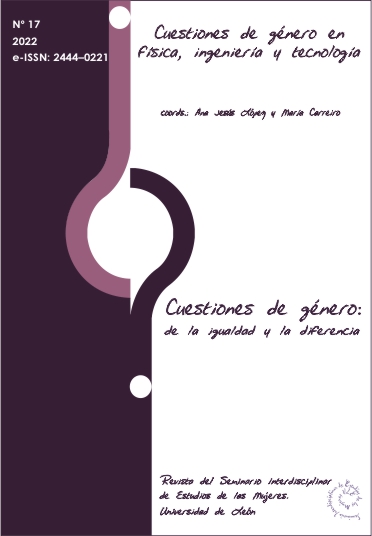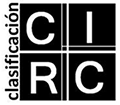If Monique Wittig had been a physicist
DOI:
https://doi.org/10.18002/cg.i17.7252Keywords:
Quantum mechanics, heterosexuality, Monique Wittig, feminist epistemologyAbstract
Some reflections and interpretations of reality provided by the theoretical aspects of feminism, such as feminist theory and feminist epistemologies, have logical, structural and conceptual parallels with quantum physics. “It is oppression that creates sex, not the other way around”. With this statement, Monique Wittig argues against the idea that gender is a consequence of sex, offering the possibility to think about sex as a consequence of gender. I align this idea with the concept of collapse in quantum mechanics where the need to understand the result of the measurement as a consequence of it is not only a philosophical interpretation of a scientific theory but an observed effect and something necessary to the same scientific theory.
Downloads
Métricas alternativas
References
Butler, Judith (1985): “Variations on sex and gender: Behaviour Wittig, and Foucault”. En: Praxis International, vol. 5, nº. 4, pp. 505-516.
Butler, Judith (2007): El género en disputa: el feminismo y la subversión de la identidad, Barcelona: Paidós.
Chakravartty, Anjan (2017): “Scientific Realism”. En: Edward N. Zalta (ed.): The Stanford Encyclopedia of Philosophy (Summer 2017 Edition). Disponible en: https://plato.stanford.edu/archives/sum2017/entries/scientific-realism/ [03/11/2021].
Haraway, Donna (1985): “A manifesto for cyborgs: Science, technology, and socialist feminism in the 1980s”. En: Socialist Review, nº. 80, pp. 65-108.
Harding, Sandra (1995): Feminismo y ciencia. Barcelona: Morata.
Krause, Décio (2011): “Is Priscilla, the trapped positron, an individual? Quantum physics, the use of names, and individuation”. En: Arbor, vol.187, nº. 747, pp. 61-66.
London, Fritz. i Bauer, Edmond (1983): “II. l The theory of observation in quantum mechanics”. En: John Archibald Wheeler y Wojciech Zurek (eds.): Quantum Theory and Mesurement. Princeton, NJ: Princeton University Press, pp. 217-259.
López Mosqueda, Jaime i Aboites, Vicente (2017): “La filosofía frente al objeto cuántico”. En: Revista mexicana de física, vol. 63, nº. 2, pp. 107-122.
Osorio, Carlos Rojas (2014): “Física cuántica y realidad”. En: Ceiba, vol. 13, nº. 1, pp.60-70.
Rich, Adrienne (1980): “Compulsory heterosexuality and lesbian existence”. En Signs: Journal of women in culture and society, vol. 5, nº. 4, pp. 631-660.
Rine, Abigail (2010): “Wittig, Monique”, Faculty Publications - Department of English. nº. 74, George Fox University.
Tajafuerce, Begonya Saez (2018): “Saberes situados”. En: Enrahonar. An international journal of theoretical and practical reason, nº. 60, pp. 93-108.
Wenzel, Hélène Vivienne (1981): “The text as body/politics: An appreciation of Monique Wittig's writings in context”. En: Feminist Studies, Tomo 7, nº. 2, pp. 264-287.
Wittig, Monique (2006): El pensamiento heterosexual y otros ensayos. Barcelona: Egales, 3ª Ed.
Downloads
Published
How to Cite
Issue
Section
License
Copyright (c) 2022 Cristina Manzano Balsells

This work is licensed under a Creative Commons Attribution-NonCommercial-ShareAlike 4.0 International License.
L@s autores/as que publican en esta revista están de acuerdo con los siguientes términos:
1. L@s autores/as ceden de forma no exclusiva los derechos de explotación (reproducción, distribución, comunicación pública, transformación) a la Universidad de León, por lo que pueden establecer, por separado, acuerdos adicionales para la distribución no exclusiva de la versión de la obra publicada en la revista (por ejemplo, alojarlo en un repositorio institucional o publicarlo en un libro), con un reconocimiento de su publicación inicial en esta revista.
2. Este trabajo se encuentra bajo la Creative Commons Attribution-NonCommercial-ShareAlike 4.0 International License. Puede consultarse desde aquí la versión informativa y el texto legal de la licencia.
3. Se permite y se anima a l@s autores/as a difundir electrónicamente las versiones pre-print (versión antes de ser evaluada) y/o post-print (versión evaluada y aceptada para su publicación) de sus obras antes de su publicación, ya que favorece su circulación y difusión más temprana y con ello un posible aumento en su citación y alcance entre la comunidad académica.
Cuestiones de Género utiliza exclusivamente la licencia Atribución-NoComercial-CompartirIgual 4.0 Internacional (CC BY- NC-SA 4.0).
Bajo los siguientes términos:
- Atribución: Usted debe dar crédito de manera adecuada , brindar un enlace a la licencia, e indicar si se han realizado cambios . Puede hacerlo en cualquier forma razonable, pero no de forma tal que sugiera que usted o su uso tienen el apoyo de la licenciante.
- No Comercial: Usted no puede hacer uso del material con propósitos comerciales .
- Compartir Igual: Si remezcla, transforma o crea a partir del material, debe distribuir su contribución bajo la la misma licencia del original. cualquier uso permitido por la licencia.
No hay restricciones adicionales — No puede aplicar términos legales ni medidas tecnológicas que restrinjan legalmente a otras a hacer
L@s autores/as pueden consultar los derechos de copyright y las condiciones de autoarchivo en el directorio Dulcinea.










